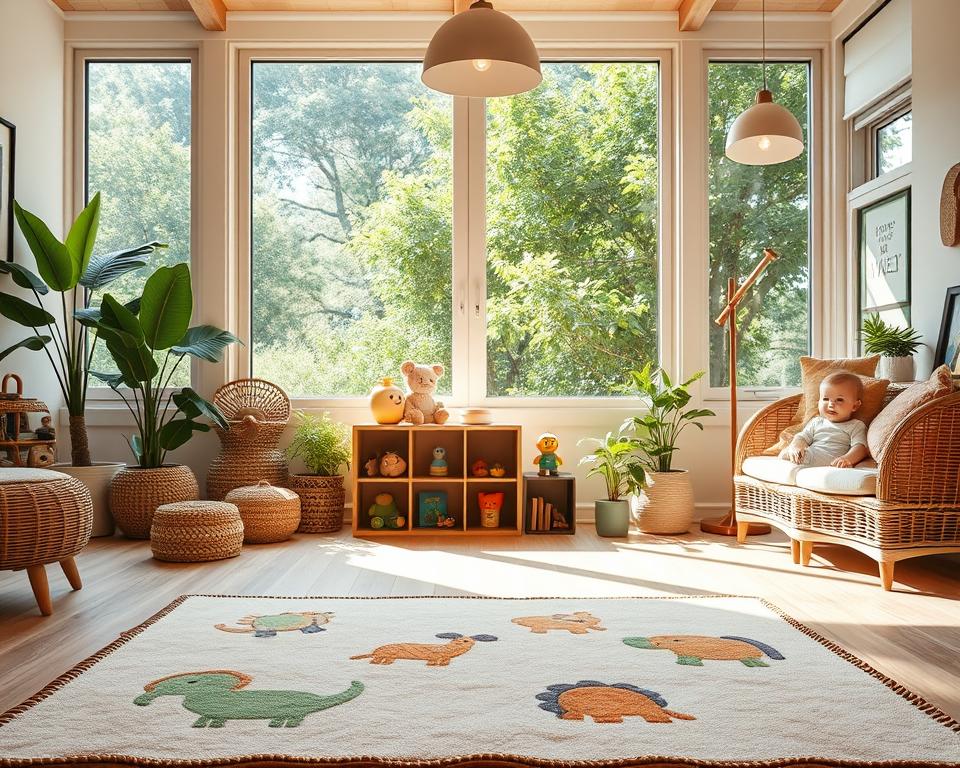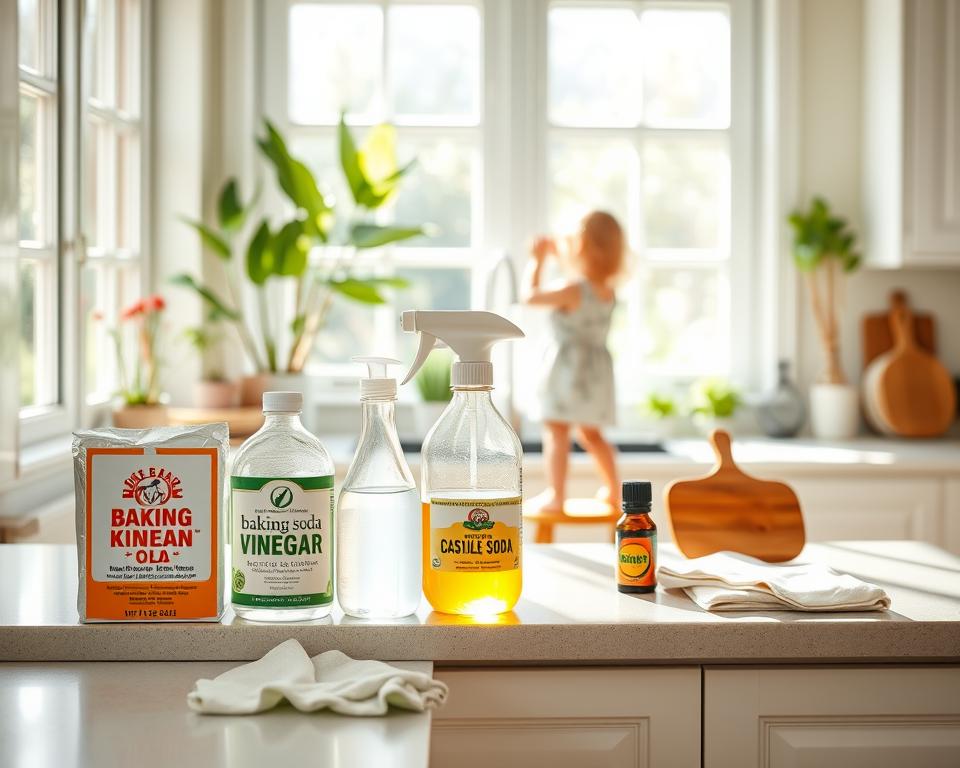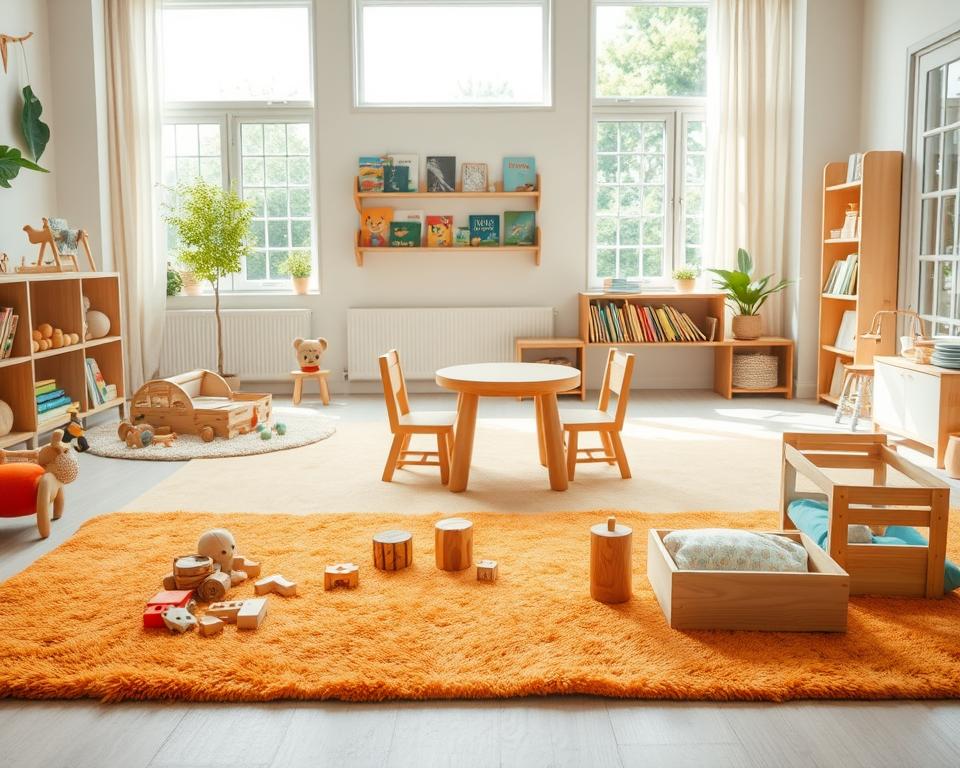Did you know that 70% of children’s exposure to toxic substances happens at home? From the air we breathe to the furniture we use, everyday items can silently affect a child’s health. As a parent, I realized how crucial it is to create a safe space for my little one to grow and learn.
Many parents don’t realize that common household items, like paints and cleaning supplies, can release harmful chemicals. These toxins can impact a child’s developing brain and body. It’s not just about avoiding obvious dangers—it’s about making thoughtful choices for their well-being.
In this article, we’ll explore how to create a toxin-free environment that supports your child’s health. You’ll find practical tips to transform your home into a safer space. Let’s take the first step toward a healthier future for your family.
Key Takeaways
- 70% of children’s toxin exposure occurs at home.
- Common household items can release harmful chemicals.
- Toxins can affect a child’s brain and body development.
- Creating a safe space requires thoughtful choices.
- Practical tips can help transform your home.
Understanding the Importance of Toxin-Free Play Spaces
Children’s developing bodies are especially sensitive to harmful chemicals. Their smaller size and hand-to-mouth habits make them more vulnerable to toxins than adults. Everyday items like synthetic carpets and plastic toys can release harmful particles into the air, affecting their health.
How Toxins Affect Toddler Development
Studies show that chemicals like flame retardants and phthalates can disrupt a child’s development. These toxins are often found in household dust and can impact brain function and immune systems. For example, plastic items can off-gas toxins, leading to hormone disruption and other health issues.
Even low levels of exposure to chemicals like BPA and lead can affect a child’s IQ and attention span. Parents need to be aware of these risks and take steps to reduce exposure. Choosing safer materials and maintaining a clean space can make a big difference.
The Role of Parents in Creating a Safe Environment
Parents play a key role in protecting their child from harmful toxins. Simple changes, like using non-toxic cleaners and avoiding synthetic carpets, can reduce chemical exposure. Regular vacuuming with a HEPA filter can also help remove harmful particles from the air.
Every little change counts. By making thoughtful choices, parents can create a safer environment for their child to grow and thrive. It’s not just about avoiding obvious dangers—it’s about making informed decisions for their well-being.
Creating a Safe and Toxin-Free Toddler Play Environment
Transforming your home into a low-toxin space doesn’t have to be overwhelming. Start with small, practical steps to reduce harmful chemicals in your child’s play area. Every change you make contributes to a healthier environment for your little one.

Practical Steps for a Healthier Play Area
Begin by reducing chemical exposure in your home. Swap out synthetic materials for natural alternatives like wood or organic cotton. These choices can significantly lower the presence of harmful substances in your child’s space.
When selecting toys and furnishings, opt for items made from safe, non-toxic materials. Look for certifications like GOTS or OEKO-TEX to ensure they meet safety standards. This simple step can make a big difference in creating a healthier environment.
Keep clutter to a minimum. A well-organized space not only looks better but also reduces dust and allergens. Use storage solutions that are easy to clean and made from low-toxin materials.
Implement one change at a time. Whether it’s switching to natural cleaning products or replacing a plastic toy with a wooden one, every step counts. Remember, it’s about progress, not perfection.
By making informed decisions and taking gradual steps, you can create a safer, healthier space for your child to grow and thrive. Small changes today can lead to a brighter, healthier future.
Materials, Furniture, and Flooring Considerations
Choosing the right materials for your child’s space can significantly impact their health and well-being. From furniture to flooring, every item plays a role in creating a safe and healthy environment. Let’s explore how to make the best choices for your little one.
Choosing Low Toxin Materials and Natural Textiles
When updating a playroom, selecting low-toxin materials is crucial. Synthetic carpets and plastic items often contain harmful chemicals like formaldehyde and PVC. These can release toxins into the air, affecting your child’s health.
Opt for natural textiles like organic cotton for drapes and pillows. Look for certifications like GOTS to ensure safety. Natural rugs are a better choice than synthetic carpets, as they minimize exposure to flame retardants and phthalates.
Furniture Options: Wood Versus Plastic
Furniture is another key consideration. Plastic items may seem convenient, but they often contain harmful chemicals. Wood, on the other hand, is a safer and more sustainable option.
Unfinished wooden pieces are ideal, as they allow you to finish them with non-toxic products. This ensures no harmful chemicals are introduced into your child’s space. Always check product safety sheets from manufacturers to confirm non-toxic standards.
- Choose natural textiles like organic cotton for upholstery.
- Opt for unfinished wood furniture to avoid harmful finishes.
- Use natural rugs instead of synthetic carpets.
- Research product safety sheets before purchasing.
By making informed decisions, you can create a healthier space for your child. Small changes in materials and furniture can lead to a safer and more nurturing environment.
Promoting Healthy Habits Through Toxin-Free Cleaning and Maintenance
Keeping your child’s space clean doesn’t mean sacrificing their health. While maintaining a tidy area is important, over-sanitizing can strip away beneficial microbes that support immune development. A balanced approach ensures cleanliness without compromising well-being.

Effective Cleaning Routines Without Over-Sanitizing
Establishing a regular cleaning routine is essential to reduce dust, allergens, and toxin buildup. However, it’s equally important to avoid harsh chemicals that can harm your child’s health. Here’s how to clean effectively while keeping things safe:
- Use non-toxic cleaners: Opt for natural ingredients like vinegar, baking soda, or lemon. These are effective and safe for surfaces your child touches.
- Clean soft items naturally: Plush toys and fabrics can harbor dust mites. Use high heat in the dryer or a quick freezer treatment to eliminate them without chemicals.
- Maintain airflow: Open windows periodically to refresh the air and reduce indoor pollutants. This simple step can significantly improve air quality.
Make sure to balance hygiene with the benefits of low-level microbial exposure. This helps your child’s immune system develop naturally while keeping the area clean.
By focusing on non-toxic methods and maintaining proper airflow, you can create a healthier space for your child. Small changes in your cleaning routine can make a big difference over time.
Engaging Playroom Ideas for Open Ended and Sensory Play
Exploring new ways to engage your child can be both fun and beneficial for their growth. A well-designed playroom encourages creativity, problem-solving, and sensory exploration. Let’s dive into some ideas that make learning enjoyable and safe.
Sensory Play to Boost Development and Creativity
Sensory activities are a fantastic way to spark curiosity and development in young minds. Activities like water tables allow children to explore concepts like pouring and measuring. Using different-sized cups, they can learn about quantities while having fun.
Natural materials like rice, beans, or sand can also be used for tactile play. These items are safe and encourage fine motor skills. Adding scoops, funnels, or small containers can turn this into a hands-on learning experience.
Art projects with non-toxic supplies, such as plant-based crayons or natural clay, are another great option. These activities not only foster creativity but also ensure your child’s space remains free from harsh chemicals.
Open Ended Toys and Clutter-Free Storage Solutions
Open-ended toys, like wooden blocks or stacking rings, encourage imaginative play. These items allow children to use them in multiple ways, promoting problem-solving and critical thinking. One toy can become many things, from a tower to a pretend car.
To keep the space organized, consider natural storage solutions like wooden shelves or woven baskets. Labeling bins can teach responsibility and make cleanup easier. A clutter-free area helps children focus and enjoy their playtime more.
- Use open-ended toys to encourage creativity and problem-solving.
- Incorporate natural storage solutions like wooden shelves.
- Label bins to teach responsibility and simplify cleanup.
By integrating these ideas, you can create a playroom that is both engaging and safe. Small changes can make a big difference in your child’s development and happiness.
Conclusion
Creating a safe space for your child involves thoughtful choices and small, impactful steps. By selecting natural materials like wood and cotton, you can reduce exposure to harmful chemicals found in plastic and synthetic items. Regular cleaning with non-toxic products ensures surfaces stay clean without introducing harsh substances into the air.
Every component in your child’s room matters. From furniture to toys, opting for safer alternatives can make a big difference. Open-ended toys encourage creativity, while natural storage solutions keep the area organized and clutter-free.
Remember, it’s about progress, not perfection. Small changes, like swapping a plastic toy for a wooden one or using natural cleaners, add up over time. These steps contribute to a healthier, more nurturing environment for your child to grow and thrive.
Continue exploring innovative ideas to keep your child’s space safe and enriching. With mindful choices, you can create a space that supports their development while ensuring their well-being. Every step you take today builds a brighter, healthier future.
